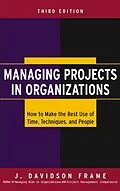In this third edition of Managing Projects in Organizations,J. Davidson Frame updates and expands on his classic book toprovide an accessible introduction to the field of projectmanagement. Drawing on more than twenty-five years of consultingand training experience, Frame's most current edition of hislandmark book includes a wealth of new topics, including:
* Managing virtual teams
* The evolving concept of the project manager's role
* Comanaged project teams
* The project office
* Project portfolios
* Web-based project management
* International project management
Autorentext
J. Davidson Frame is Dean of Academic Affairs at the University of Management and Technology (UMT) in Arlington, Virginia. Prior to joining UMT, he established the project management program at George Washington University. He also served as director of the Project Management Certification Program at the Project Management Institute (PMI) and has served on PMI's board of directors. Frame has authored more than forty articles and seven books, including The New Project Management (2nd edition) and Managing Risk in Organizations.
Klappentext
Your Handbook for Managing Projects
In this third edition of Managing Projects in Organizations, J. Davidson Frame updates and expands on his classic book to provide an accessible introduction to the field of project management. Drawing on more than twenty-five years of consulting and training experience, Frame's most current edition of his landmark book includes a wealth of new topics, including:
- Managing virtual teams
- The evolving concept of the project manager's role
- Co-managed project teams
- The project office
- Project portfolios
- Web-based project management
- International project management
Praise for J. Davidson Frame and His Books
"Frame has a deep understanding of the systemic nature of project management."
Quality Progress
"The New Project Management examines the new realities of project management: managing risk, maintaining quality of goods and services, outsourcing, satisfying customers, and communicating effectively with managers, customers, vendors, and staff."
PM Network
"An excellent book I'd recommend is Managing Projects in Organizations by J. Davidson Frame. . . . Can help you put your project management skills on track."
Microsoft Certified Professional Magazine
"Provides an excellent overview of the fundamental concepts of project management."
Public Productivity Management Review
Zusammenfassung
In this third edition of Managing Projects in Organizations, J. Davidson Frame updates and expands on his classic book to provide an accessible introduction to the field of project management. Drawing on more than twenty-five years of consulting and training experience, Frame's most current edition of his landmark book includes a wealth of new topics, including:
- Managing virtual teams
- The evolving concept of the project manager's role
- Comanaged project teams
- The project office
- Project portfolios
- Web-based project management
- International project management
Inhalt
Preface.
The Author.
1. The New Business Environment and the Need for a New Project Management.
The New Business Environment.
The Problem with the Traditional Approach to Project Management.
The New Project Management.
Traits of the New Project Manager.
The Increased Value of Project Managers.
Conclusions.
PART ONE: MANAGING IN THE NEW BUSINESS ENVIRONMENT.
2. Managing Complexity: Techniques for Fashioning Order Out of Chaos.
Chaos and Complexity.
Facets of Complexity.
Experience with Project Complexity.
How to Manage Complexity.
Conclusions.
3. Engaging Change: Knowing When to Embrace, Accept, or Challenge.
Sources of Change.
Change Management Strategies.
Going with the Flow of Rapid Prototyping.
Resisting Change with Configuration Management.
Basic Steps in Developing a System with Configuration Management.
Change Control.
Conclusions.
4. Managing Risk: Identifying, Analyzing, and Planning Responses.
Perspectives on Risk.
Risk and Variability.
Range of Risks.
Sources of Risk on Projects.
Risk-Reward Trade-Offs.
Risk and Time Horizons.
Risk Exposure.
Risk Management.
Modeling.
Conclusions.
5. Satisfying Customers: Knowing Who They Are, What They Want, and When They are Right or Wrong.
Who Are Our Customers?
Meeting Customer Expectations.
Understanding Customers' Needs and Requirements.
Traits of Effective Needs Analysts.
Steps for Improving Needs Definition.
Customers' Responsibilities in Defining Their Needs.
Organizing to Achieve Customer Satisfaction.
What to Do When Customers Don't Cooperate.
Conclusions.
6. Defining Requirements that Bridge the Customer-Developer Gap.
The Place of Needs and Requirements in the Project Management Process.
Capturing Requirements.
Key Players in the Requirements Definition and Management Process.
The Communication Challenge: I Can't Read Your Mind.
The Standard Communication Model.
Tips for Handling Requirements.
Bringing It Together with Joint Application Development JAD) · Conclusion
PART TWO: TOOLS FOR THE NEW PROJECT MANAGEMENT.
7. Acquiring Political Skills and Building Influence.
What Is Politics?
Politics in Projects.
Players to Contend with in the Project Environment.
Being a Better Politician.
A Guide to Action.
Building Authority.
Using Authority Effectively.
Managing Our Managers.
Conclusions.
8. Building Teams with Borrowed Resources.
Make the Team as Tangible as Possible.
Develop Rewards for Good Behavior.
Develop an Effective Personal Touch.
Self-Managed Teams: Prospectus and Pitfalls.
Structuring the Team.
Conclusions.
9. Selecting Projects That Will Lead to Success.
The Essence of Choice.
Benefit-Cost Ratios.
Buss's Technique for Rank Ordering Projects.
Poor Man's Hierarchy.
The Murder Board.
Peer Review.
General Rules for Selecting Projects.
Conclusions.
10. Estimating Realistic Costs, Schedules, and Specifications to Ensure Project Success.
Causes of Poor Estimation.
The 10 Percent Optimist.
Traditional Approaches to Cost Estimating.
Bottom-Up Versus Top-Down Estimates.
Life Cycle Cost Estimating.
Strategies for Dealing with Poor Estimates.
Conclusions.
11. Scheduling Projects with New Tools: The Time-boxed and Critical Chain Scheduling Techniques.
Time-boxed Scheduling.
What Needs to be Prioritized?
Bringing Together Pertinent Players.
What Nee...
